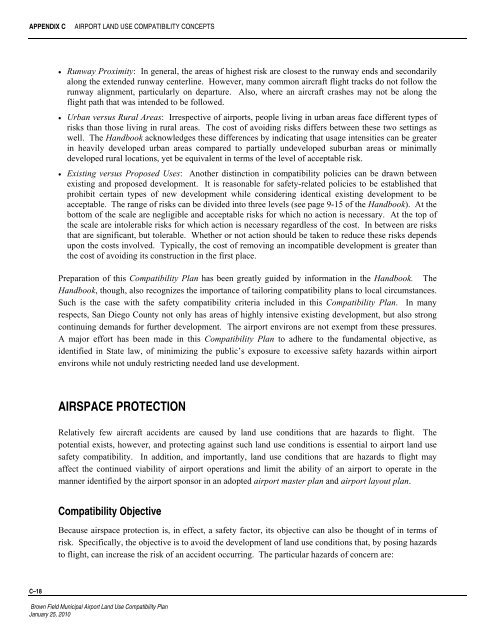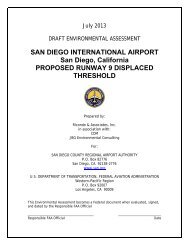Brown Field Municipal Airport Land Use Compatibility Plan
Brown Field Municipal Airport Land Use Compatibility Plan
Brown Field Municipal Airport Land Use Compatibility Plan
- No tags were found...
Create successful ePaper yourself
Turn your PDF publications into a flip-book with our unique Google optimized e-Paper software.
APPENDIX CAIRPORT LAND USE COMPATIBILITY CONCEPTS• Runway Proximity: In general, the areas of highest risk are closest to the runway ends and secondarilyalong the extended runway centerline. However, many common aircraft flight tracks do not follow therunway alignment, particularly on departure. Also, where an aircraft crashes may not be along theflight path that was intended to be followed.• Urban versus Rural Areas: Irrespective of airports, people living in urban areas face different types ofrisks than those living in rural areas. The cost of avoiding risks differs between these two settings aswell. The Handbook acknowledges these differences by indicating that usage intensities can be greaterin heavily developed urban areas compared to partially undeveloped suburban areas or minimallydeveloped rural locations, yet be equivalent in terms of the level of acceptable risk.• Existing versus Proposed <strong>Use</strong>s: Another distinction in compatibility policies can be drawn betweenexisting and proposed development. It is reasonable for safety-related policies to be established thatprohibit certain types of new development while considering identical existing development to beacceptable. The range of risks can be divided into three levels (see page 9-15 of the Handbook). At thebottom of the scale are negligible and acceptable risks for which no action is necessary. At the top ofthe scale are intolerable risks for which action is necessary regardless of the cost. In between are risksthat are significant, but tolerable. Whether or not action should be taken to reduce these risks dependsupon the costs involved. Typically, the cost of removing an incompatible development is greater thanthe cost of avoiding its construction in the first place.Preparation of this <strong>Compatibility</strong> <strong>Plan</strong> has been greatly guided by information in the Handbook. TheHandbook, though, also recognizes the importance of tailoring compatibility plans to local circumstances.Such is the case with the safety compatibility criteria included in this <strong>Compatibility</strong> <strong>Plan</strong>. In manyrespects, San Diego County not only has areas of highly intensive existing development, but also strongcontinuing demands for further development. The airport environs are not exempt from these pressures.A major effort has been made in this <strong>Compatibility</strong> <strong>Plan</strong> to adhere to the fundamental objective, asidentified in State law, of minimizing the public’s exposure to excessive safety hazards within airportenvirons while not unduly restricting needed land use development.AIRSPACE PROTECTIONRelatively few aircraft accidents are caused by land use conditions that are hazards to flight. Thepotential exists, however, and protecting against such land use conditions is essential to airport land usesafety compatibility. In addition, and importantly, land use conditions that are hazards to flight mayaffect the continued viability of airport operations and limit the ability of an airport to operate in themanner identified by the airport sponsor in an adopted airport master plan and airport layout plan.<strong>Compatibility</strong> ObjectiveBecause airspace protection is, in effect, a safety factor, its objective can also be thought of in terms ofrisk. Specifically, the objective is to avoid the development of land use conditions that, by posing hazardsto flight, can increase the risk of an accident occurring. The particular hazards of concern are:C–18<strong>Brown</strong> <strong>Field</strong> <strong>Municipal</strong> <strong>Airport</strong> <strong>Land</strong> <strong>Use</strong> <strong>Compatibility</strong> <strong>Plan</strong>January 25, 2010
















